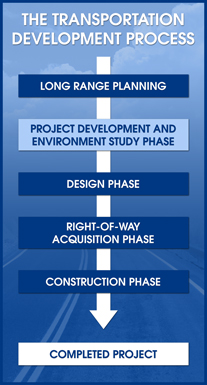A PD&E Study is the FDOT’s process for adhering to the National Environmental Policy Act and involves a range of engineering and environmental analyses and public involvement.
A PD&E Study assists the FDOT to determine the location, conceptual design, and social, economic, and environmental effects of the proposed project. During the PD&E Study, “Build” alternatives are developed and evaluated based on safety measures, environmental and engineering analyses, and public input. In addition, the “No Build” alternative remains a viable option throughout the PD&E Study phase.
If the study results in a “Build” alternative being selected, and funding is available, the project may proceed to the design phase.
Five Steps in the Transportation Development Process

- Long Range Planning: The FDOT and local agencies conduct long-range transportation planning on an ongoing basis to identify and prioritize projects.
- Project Development and Environment Study: As described above, the PD&E Study phase involves conceptual engineering, environmental evaluations, and public involvement. It is during this phase that alternatives are evaluated; if a “Build” alternative is selected, and funding is available, the project would move into the design phase.
- Design: During the design phase, construction plans are prepared.
- Right-Of-Way Acquisition: This phase entails the purchase and acquisition of right-of-way, if needed.
- Construction: The roadway is built during this phase.
